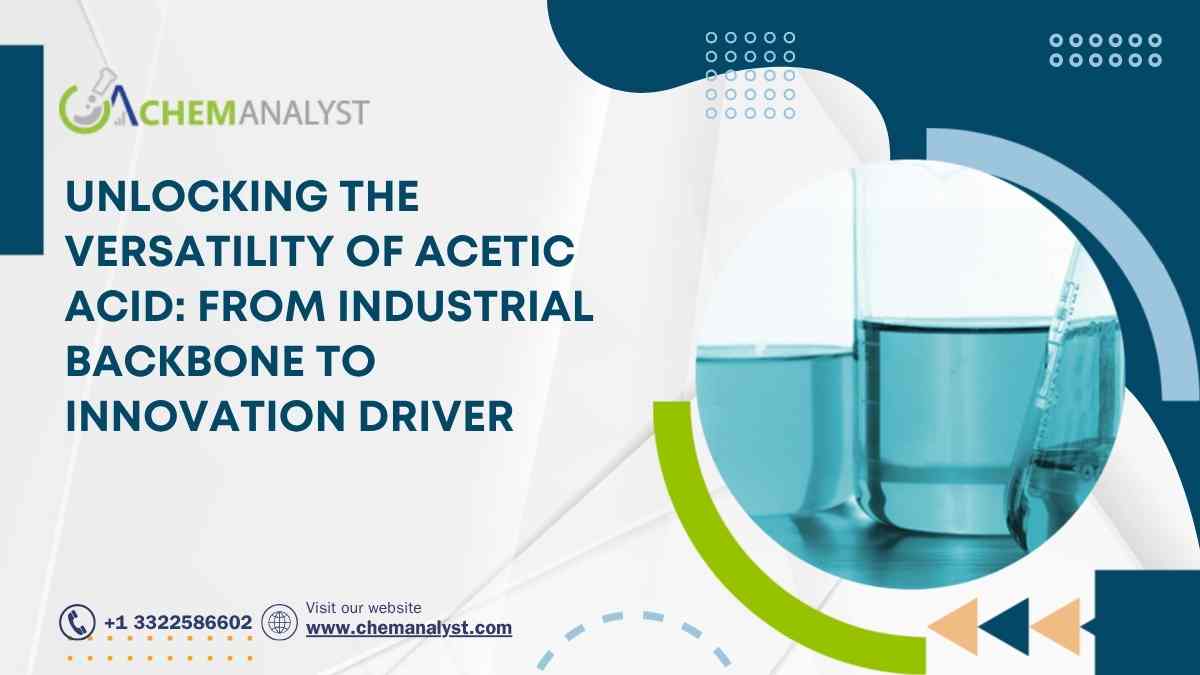Welcome To ChemAnalyst

From vinegar to vinyl acetate monomer, this blog showcases the diverse industrial and consumer uses of acetic acid and its growing role in sustainable chemistry.
I. Introduction
Colourless, clear liquid organic carboxylic acid CH3COOH, or acetic acid, possesses a pungent vinegar-like odour. While most commonly referred to as the chief component in vinegar, industrial-strength acetic acid plays a far more predominant role in various manufacturing industries. An integral chemical synthesis intermediate, its applications vary from plastics manufacture to food preservation. Because it can dissolve as well as react, acetic acid has emerged as a critical ingredient used in automotive, pharma, textile, and construction sectors. As industrialization continues to grow around the world and there is increased focus on sustainability, the demand for the multifaceted acid continues to increase steadily in both developed and developing economies.
II. Industrial Applications by Sector
Automotive & Transportation
Acetic acid plays a crucial role in the manufacture of polyvinyl acetate (PVA) and polyethylene terephthalate (PET), which finds extensive application in automotive coatings, adhesives, and lightweight composite materials. It increases fuel efficiency by allowing lighter vehicle construction and helps in corrosion resistance.
Construction & Infrastructure
In the construction sector, acetic acid polymers such as polyvinyl acetate are utilized in caulks, sealants, and paints. Its application adds water resistance, adhesion, and flexibility—features essential to modern construction in diverse climates.
Electronics & Electricals
Acetic acid aids in the production of high-purity acetic anhydride used in the production of insulating films as well as semiconductor manufacturing solvents. It adds chemical stability and precision in etching essential for intricate circuitry.
Agriculture & Fertilizers
In agrochemicals, acetic acid is used as a raw material for the production of herbicides and insecticides. Due to its effectiveness and biodegradability, it has uses in sustainable agriculture. It's also under research for adjusting soil pH.
Healthcare & Pharmaceuticals
Pharmaceutical grade acetic acid is used to produce aspirin, acetanilide, and other APIs. Its sterilizing property also makes it a component of wound care products and topical antibacterials.
Food & Beverage
Acetic acid is employed as a food preservative (E260), flavoring, and pH control agent in food production. It inhibits microbial growth on pickled vegetables, condiments, and sauces, providing extended shelf life and safety.
III. Market Demand and End-User Industries
The global demand for acetic acid is driven by strong demand from end-use industries such as textiles, adhesives, and plastics. Asia-Pacific is driving consumption, led by China and India, because of expanding manufacturing hubs and urbanization-related infrastructure development. Polyester production, based on purified terephthalic acid (PTA) from acetic acid, significantly boosts demand in both textile and packaging segments. Pharmaceuticals and agrochemicals are emerging as other key growth segments, especially with expanding healthcare access and agricultural modernization. Moreover, its shift to bio-based acetic acid has attracted interest from companies seeking cleaner production streams. As a result, the market presence of the compound is widening beyond traditional consumers, backed by global drivers of sustainability and compliance trends.
IV. Grades and Specifications
The compound exists in a variety of grades to suit different industry applications. Glacial Acetic Acid (99–100% purity) is the industrial favorite, utilized in plastics, chemicals, and textiles. Food-grade acetic acid (traditionally 4–8%) meets high standards of safety and is utilized in food and beverages. Pharmaceutical-grade acetic acid is produced under strict control to ensure safety and purity for drug manufacture. Suppliers will tailor parameters such as water content, colour, and trace metal level according to use. The ability to formulate acetic acid according to specific needs makes it versatile in a diverse range of end-use products, from cleanroom-quality electronics solvent to biodegradable herbicide.
V. Substitutes and Limitations
Acetic acid faces the risk of replacement with other options like formic acid, citric acid, and man-made solvents like toluene in some uses. Citric acid, if utilized in adhesives or preservatives, can impart a more natural profile, while toluene can impart higher volatility for some chemical reactions. Nonetheless, acetic acid is the go-to for cost efficiency, predictable reactivity, and versatility. Its sole shortcoming is corrosiveness at high concentration, which demands special storage and handling. Even that, however, makes it difficult to replace completely, especially in bulk industrial uses where economics and integration into the supply chain are the major issues.
VI. Innovations in Applications
New technologies are changing acetic acid usage, especially in the drive for cleaner solutions. Bio-based acetic acid, produced through fermentation of biomass instead of petrochemical processes, is on the rise. Industry leaders are investing in sustainable acetic acid to manage carbon footprints, a good case in point being Celanese's pilot programs for renewable acetic acid. In advanced technological applications, scientists are testing acetic acid as a carrier in applications for application in 3D-printable polymers used in medical devices and electronic parts. Acetic acid is used in solar panel cleaners because it is biodegradable and non-toxic. One example was a European packaging firm replacing synthetic adhesives with PVA manufactured from acetic acid, which had reduced VOC emissions and boosted recyclability. With greater catalysis and fermentation, uses of acetic acid continue to widen into the next-generation materials and circular economy technologies.
VII. Conclusion
Acetic acid is a key industrial chemical, facilitating a broad range of industries from food preservation to automobile innovation. Its versatility, affordability, and chemical properties make it a staple in both old and new applications. With innovation and sustainability redefining global production, acetic acid is set to remain one of the leading players, particularly with mounting bio-based and specialty derivative growth. Strong Asian demand and growing applications in healthcare, electronics, and green chemistry ensure that the acetic acid market will continue to grow steadily. Developments in future fermentation technologies and application science will increasingly highlight its role in the global chemical economy.
We use cookies to deliver the best possible experience on our website. To learn more, visit our Privacy Policy. By continuing to use this site or by closing this box, you consent to our use of cookies. More info.
